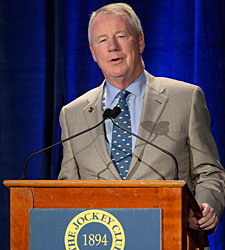The Jockey Club to Help Fund Drug Testing

The Jockey Club will provide up to $500,000 in 2014-15 to some racing jurisdictions to step up out-of-competition drug testing with a focus on graded stakes.
The initiative, announced Aug. 11 at The Jockey Club Round Table in Saratoga Springs, N.Y., signals more involvement by the organization in the area of medication and equine drug testing. Much of this year's Round Table conference dealt with drugs and how their use is perceived in horse racing.
Jockey Club vice chairman Stuart Janney III said about one-third of racing regulatory agencies have rules that permit out-of-competition testing. Many of them, however, don't conduct the screenings in part because of cost or legal issues.
Janney cited some progress. In 2012-13, the Kentucky Horse Racing Commission tested each starter in the Kentucky Derby Presented by Yum! Brands (gr. I) at least twice before the race, and in New York, the New York State Gaming Commission tested starters in two grade I events: the Belmont Stakes and Wood Memorial Stakes.
Out-of-competition testing, which generally is done to detect blood-doping agents, could be done for the Travers Stakes (gr. I) in late August and the Breeders' Cup World Championships in early November, Janney said.
Under The Jockey Club grant structure, jurisdictions that receive funds to pay for the testing must expand it to test for other Class 1 substances such as steroids and dermorphin, also known as "frog juice." Others would be added to the list as tests are developed.
The Jockey Club will make up to $250,000 available in 2014, and the same amount for 2015.
"(Out-of-competition testing) plays an increasingly important role in doping control as organizations and regulatory authorities try to combat the growing sophistication of substances that enhance performance," Janney said. "It can be a powerful deterrent and, in our sport, it is a perfect bookend to post-race sampling.
"We know that new technologies are capable of creating long-lasting performance enhancement effects when administered weeks prior to the competition, and there are substances that leave no traces or residues detectable during normal, post-competition testing."
The Jockey Club Aug. 11 also released the results of a survey of 816 "committed bettors and handicappers" that shows drug and integrity issues to be of high importance. The survey, conducted by Penn Schoen Berland, sampled 403 racing fans, 401 potential racing fans, and 28 "whales," or those who bet more than $50,000 a month.
The Penn Schoen Berland survey showed 69% found drugs in racing to be the most important concern, followed by integrity at 66%. The company said those issues are more important to those surveyed than pari-mutuel takeout rates, lack of leadership, outmoded facilities, and racing-related injuries.
The survey suggests four in five big bettors believe the drug issue is "very important." The same 80% said takeout rates are "very important" as well.
The issue of takeout—the amount of money taken from every dollar bet to support purses, operations, and, more recently, rebates for big bettors--–has never been addressed by the industry at large. The survey doesn't indicate why big bettors who get rebates–in effect a 5% to 10% reduction in takeout–believe the rates are an important issue.
"The commitment to reforming the sport by cleaning up its drug and integrity issues is strong and deep among committed bettors, including 'big fish' and whales," the company said in a summary of the survey results. "It is about more than tougher punishments for cheaters and more disclosure for handicappers. True drug and integrity reform favored by committed bettors also entails changing the philosophy behind therapeutic uses of drugs in Thoroughbred racing.
"Most bettors (57%) would like to see horses only allowed to race when free from the influence from any medication or drugs rather than treated with therapeutic medication up until the day of a race. Support for changing to a medication-free philosophy is also favored by three in five current fans (60%) and two in three potential fans (67%)."
